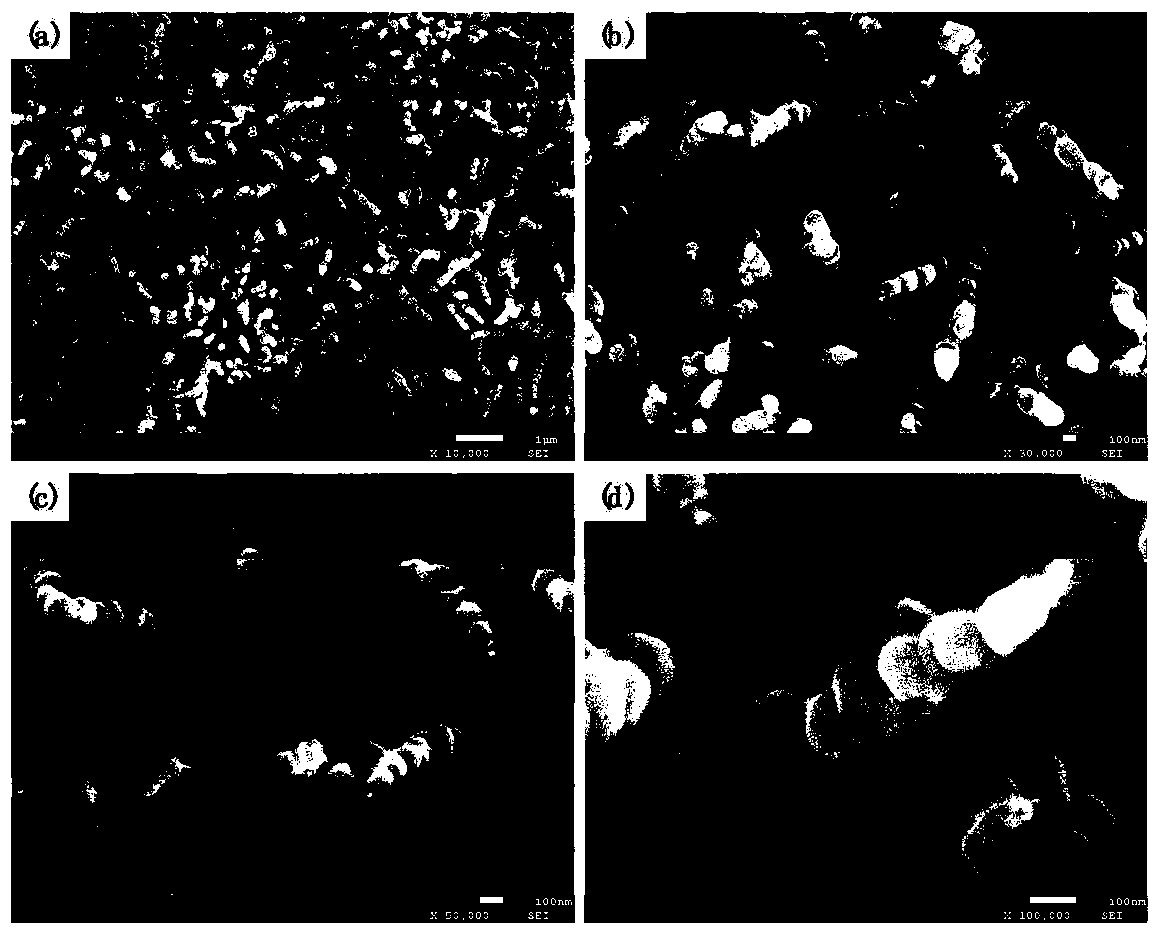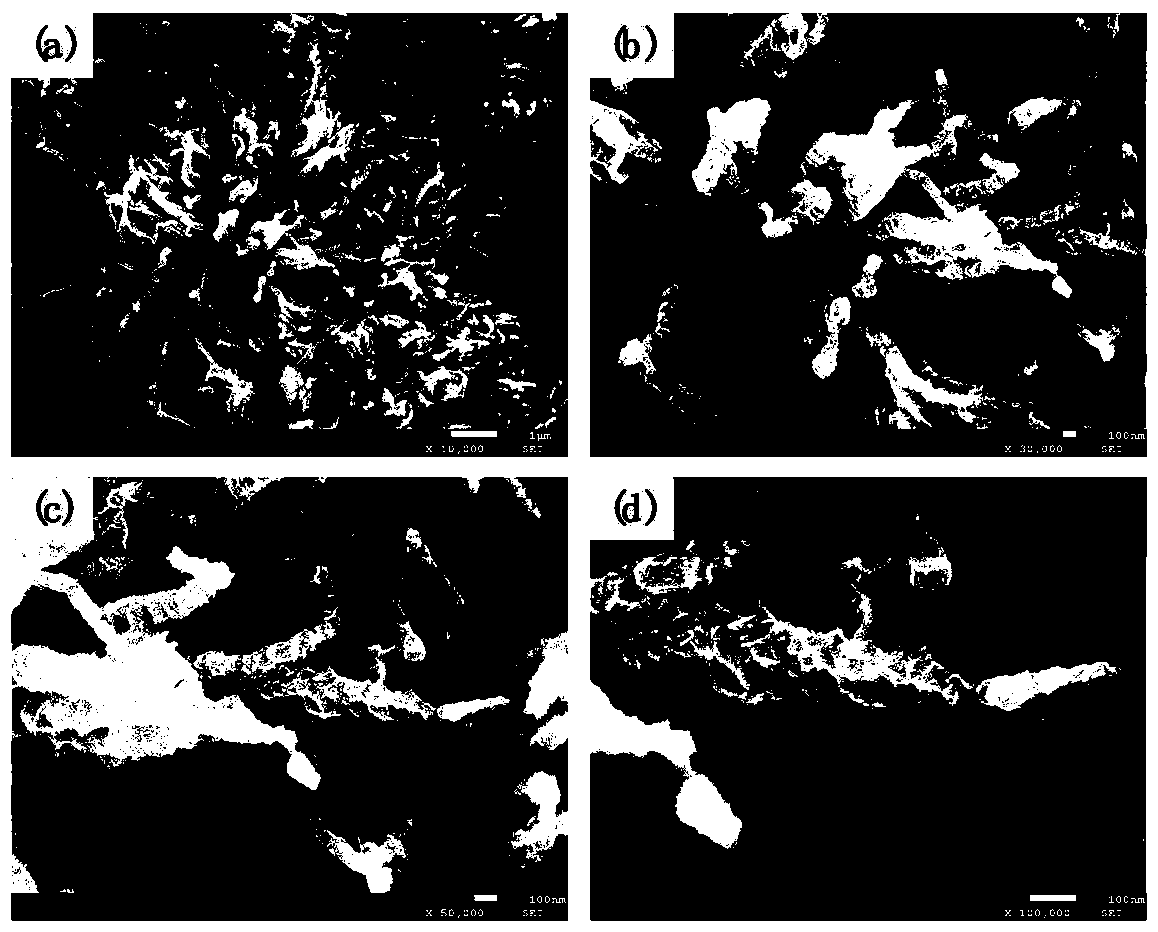Preparation method of molybdenum disulfide nanosheet @ cobalt sulfide nanoneedle in-situ array electrode
An array electrode, molybdenum disulfide technology, applied in the direction of cobalt sulfide, molybdenum sulfide, chemical instruments and methods, etc., can solve the problems of complicated preparation and so on
- Summary
- Abstract
- Description
- Claims
- Application Information
AI Technical Summary
Problems solved by technology
Method used
Image
Examples
Embodiment 1
[0028] The carbon paper substrate on which the cobalt tetroxide array was grown was reacted in an Ar+S atmosphere at 600° C. for 1 h, cooled naturally and then taken out for use. Dissolve molybdenum chloride in ethanol solution at room temperature, stir to dissolve, and obtain 450 mM molybdenum chloride ethanol solution. Soak the carbon paper substrate with the cobalt sulfide array in the molybdenum chloride solution, take it out and dry it on a hot table at 80°C for 10 min. Put the coated substrate into the tube furnace, ventilate Ar gas to vacuumize repeatedly three times to discharge the residual air in the tube furnace, and then ventilate Ar gas with a flow rate of 1 SCCM. 1 g of sulfur powder is placed on the upper part of the tube furnace. The temperature in the tube furnace rises, the sulfur powder evaporates to form sulfur vapor, and reacts at 600°C for 30 minutes in an Ar+S atmosphere, and takes it out after natural cooling. Among them, Co 3 o 4 The array adopts th...
Embodiment 2
[0030] The carbon paper substrate on which the cobalt tetroxide array was grown was reacted in an Ar+S atmosphere at 500° C. for 1 h, cooled naturally and then taken out for use. Dissolve molybdenum chloride in ethanol solution at room temperature, stir to dissolve, and obtain 200 mM molybdenum chloride ethanol solution. Soak the carbon paper substrate with the cobalt sulfide array in the molybdenum chloride solution, take it out and dry it on a hot table at 80°C for 10 min. Put the coated substrate into the tube furnace, ventilate Ar gas to vacuumize repeatedly three times to discharge the residual air in the tube furnace, and then ventilate Ar gas with a flow rate of 1 SCCM. The temperature in the tube furnace rises, the sulfur powder evaporates to form sulfur vapor, and reacts at 800°C for 30 minutes in an Ar+S atmosphere, and takes it out after natural cooling. Figure 5 (a) SEM image and (b) linear voltammetry scan image in 1M KOH of the molybdenum disulfide nanosheet@co...
Embodiment 3
[0032] The carbon paper substrate on which the cobalt tetroxide array was grown was reacted in an Ar+S atmosphere at 500° C. for 1 h, cooled naturally and then taken out for use. Dissolve molybdenum chloride in ethanol solution at room temperature, stir to dissolve, and obtain 330 mM molybdenum chloride ethanol solution. Soak the carbon paper substrate with the cobalt sulfide array in the molybdenum chloride solution, take it out and dry it on a hot table at 80°C for 10 min. Put the coated substrate into the tube furnace, ventilate Ar gas to vacuumize repeatedly three times to discharge the residual air in the tube furnace, and then ventilate Ar gas with a flow rate of 1 SCCM. The temperature in the tube furnace rises, the sulfur powder evaporates to form sulfur vapor, and reacts at 800°C for 30 minutes in an Ar+S atmosphere, and takes it out after natural cooling. Figure 6 (a) SEM image and (b) linear voltammetry scan image in 1M KOH of the molybdenum disulfide nanosheet@co...
PUM
 Login to View More
Login to View More Abstract
Description
Claims
Application Information
 Login to View More
Login to View More - Generate Ideas
- Intellectual Property
- Life Sciences
- Materials
- Tech Scout
- Unparalleled Data Quality
- Higher Quality Content
- 60% Fewer Hallucinations
Browse by: Latest US Patents, China's latest patents, Technical Efficacy Thesaurus, Application Domain, Technology Topic, Popular Technical Reports.
© 2025 PatSnap. All rights reserved.Legal|Privacy policy|Modern Slavery Act Transparency Statement|Sitemap|About US| Contact US: help@patsnap.com



